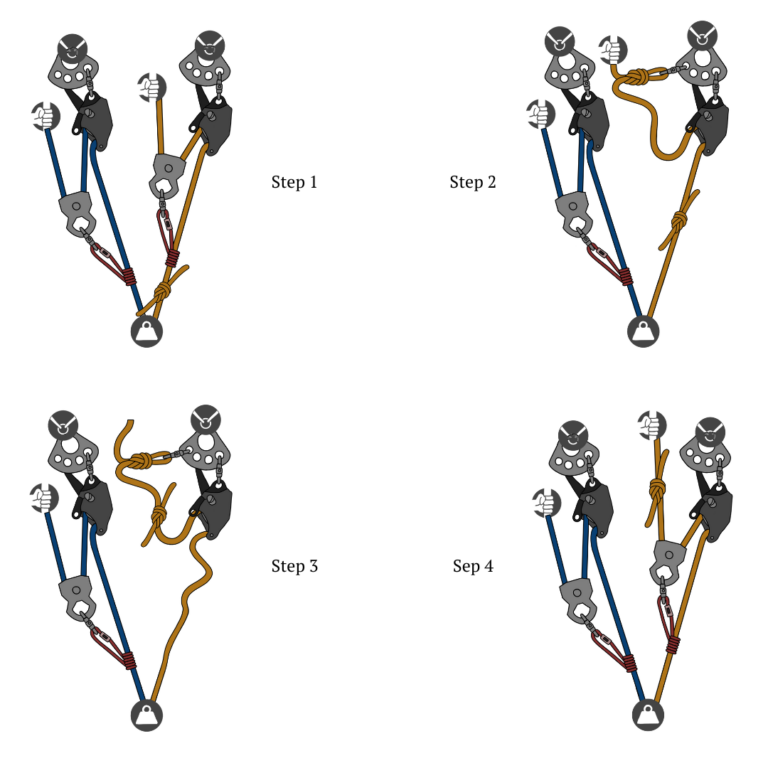Mastering the Twin Tension System for Knot Passing
Knot passing during rope rescue operations is one of the most critical and technically challenging tasks rescue teams face. The Twin Tension System (TTS) has emerged as a transformative method for simplifying this process. By leveraging staggered knot locations and allowing one side of the system to manage the load while adjustments are made on the other, the TTS ensures smoother transitions and safer operations. This technique is particularly effective in raising operations where precision, efficiency, and redundancy are paramount. Here’s an in-depth exploration of what makes the TTS indispensable, why it’s so effective, and how it works in action.
What Makes the Twin Tension System Essential?
At its core, the TTS is designed to enhance load management and operational flexibility. Traditional single-line systems, while functional, carry inherent risks due to their reliance on a single point of failure. The TTS eliminates this vulnerability by distributing the load between two ropes, creating a built-in redundancy that drastically reduces risk.
In high-pressure situations, such as a raising operation with a knot approaching a critical point, the ability to smoothly adjust the system without halting progress is vital. The TTS accomplishes this by utilizing staggered knot positions, allowing one rope to temporarily bear the load while adjustments are made on the other. This dynamic approach ensures both safety and continuity, qualities that are invaluable during complex rescues.
Why the Twin Tension System Stands Out
The beauty of the TTS lies in its efficiency, adaptability, and focus on safety. Unlike traditional methods that may require cumbersome resets or pauses in operation, the TTS allows rescue teams to keep momentum, saving precious time during high-stakes scenarios. This efficiency doesn’t compromise safety—in fact, it enhances it by maintaining continuous load control and minimizing the risk of system failure.
The TTS is also highly adaptable, compatible with a variety of mechanical advantage devices such as the Clutch or MPD. This flexibility ensures that teams can integrate the system seamlessly into their existing setups, making it a universal solution for rope rescue challenges.
How the Twin Tension System Works in Action
Imagine a scenario where a knot must pass through a Clutch during a raising operation. The TTS shines in its ability to handle such transitions with grace and precision.
Preparation and Positioning
As the operation begins, the team raises the load until the knot is positioned just below the Clutch—approximately 1.5 meters away. This spacing provides ample room for manipulation and ensures a smooth adjustment. The alternate rope is prepped with a reset Prusik hitch to take on the load as needed.
Establishing Control
To maintain full control over the system, a figure-eight loop is tied into the rope and secured to an anchor, creating a temporary holding point. This anchor ensures that the load remains stable while adjustments are made, preventing unnecessary strain on the primary rope or device.
Executing the Knot Pass
The team uses the alternate rope to haul the load slightly, relieving tension from the primary rope. The knot is then carefully repositioned above the Clutch, allowing the system to be reconfigured without disrupting the overall operation. Once the adjustment is complete, the temporary anchor is untied, and the load is redistributed across both ropes.
Resuming Operations
With the knot successfully managed, the Prusik hitch is removed, and the team continues raising the load. The 3:1 system is rigged below the Clutch to provide additional support and ensure a steady ascent. At this point, the TTS is fully re-engaged, functioning seamlessly to complete the mission.
Practical Benefits of the Twin Tension System
- Safety First
The TTS maintains redundancy, ensuring that no single point of failure jeopardizes the operation. This safety net is critical in high-stakes environments where lives are on the line. - Efficiency Under Pressure
By enabling continuous load management and smooth transitions, the TTS reduces downtime and keeps operations moving forward, even during complex adjustments. - Versatility Across Scenarios
Whether you’re working with a Clutch, MPD, or other mechanical advantage devices, the TTS adapts effortlessly to different tools and setups, making it a reliable choice for varied rescue scenarios.
Building Mastery Through Training
To fully leverage the TTS, rescue teams must prioritize regular training and scenario-based practice. Understanding the nuances of knot management, load distribution, and device compatibility is essential for flawless execution. Teams should also routinely inspect their equipment, from ropes to mechanical devices, to ensure everything is in optimal condition.
Elevating Rescue Operations with the TTS
The Twin Tension System is more than just a knot-passing technique—it’s a philosophy of efficiency, adaptability, and safety. By mastering this method, rescue teams can elevate their capabilities, ensuring smoother operations and greater success in high-pressure scenarios. Whether navigating intricate systems or facing the challenges of raising operations, the TTS stands as a dependable ally in achieving mission success.
Reference Links
- Rope Rescue Equipment: What You Need to Know
- Mastering the Art of Knot Passing in Rescue Operations
- Raising Operations with the Clutch: A Guide for Professionals
Peace on your Days
Lance










